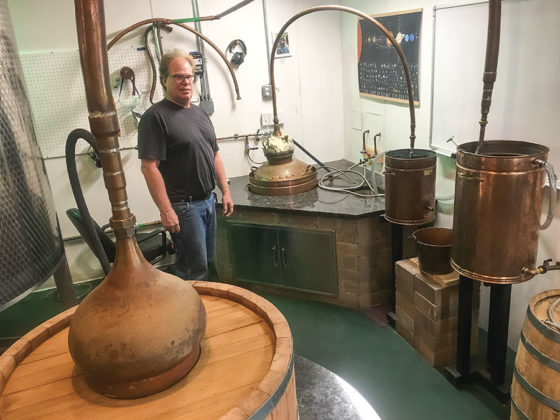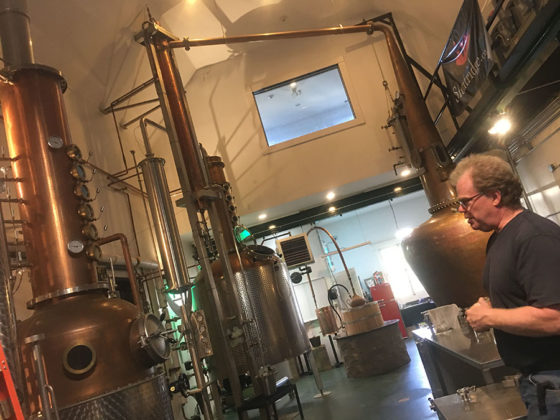Having opened in 2006 as a winery eschewing chemicals in its winemaking (unique now, more so for that time), life and work partners Steve Osborn and Kim Wagner sought to capture as much flavor as possible in wines and spirits from New York’s Hudson Valley. The UC-Davis and Cornell-educated biochemists start with a basic understanding that “most flavors are illuminated by alcohol acting as an internal light into wines and spirits.”
This attention to expressing what’s naturally occurring at the point of planting extends to their avoiding the use of vitis sourced from Europe, preferring to use the grape species native to North America. “I like genomes which are local so they reflect authenticity of place.” All of Osborn and Wagner’s source materials–grains, grasses, fruits– that’re distilled are grown within and sourced from the Hudson Valley, and with the exception of mail order all products sold within ten miles of their Marlboro site.
Osborn began building his distillery in the late 2000s launching it in 2016 on the back of the winery’s initial success and with the couple having the advantage of time spent learning about their customers’ taste preferences. They reached out to Angus McDonald who had long admired their non-interventionist winemaking methods. The now deceased local legend also told them that, “if you want to express terroir you should not only source your fermentable materials locally but also the oak for your spirits barrels.”
With John Cox at nearby QC Cooperage fashioning barrels from Hudson Valley oak the fit was natural especially as he paid Cox half down on 125 barrels at $330 each. “John’s contribution helps give us terroir to express the Hudson Valley,” said Osborn. He wanted to use wooden fermentation tanks for malt whiskies from their own malthouse, so he commissioned Cox to create 800-gallon fir fermenters from local trees positing that getting the biome of the air will impart itself into the barrel by it lodging itself into the wood and transmitting the character of the building into the mash.
“To my palate it works not by showing the fir wood character, but rather providing a suitable environment for an interaction with yeasts and/or bacteria that stimulates more complexity in the fermentation,” he mused. “This is how Scotch used to be made, in open top fermenters, with the wooden building engendering more biome interaction helping to give a foundation of greater complexity and softer palate notes.”
Process Puzzle Pieces
The reincorporation of tails from most of his spirits is relegated to Stoutridge’s vodka production with it made entirely from alcohol pulled from the tails of brandy and whiskey production. Stoutridge uses QC’s 30 gallon barrels of local oak exclusively for its rye and bourbon, furthering their desire to make whiskies that taste of the Hudson Valley.
Grains used in Stoutridge Rye75 are sourced near Albany upon sandy soils–soft and easy bottled at 43%–and West Wind, a light whiskey having come off the double distilled at over 160 proof being half corn/rye, aged six months in ex-Rye75 barrels then a year in his wine barrel solera.
“The lighter style is more expressive of the grain, more transparent and something wine-like.” After years of waiting Osborn is pleased to have recently released a single malt. His premier double-distilled grape brandy was aged 3.5 years in a former Pinot noir barrel then finished in a 2500-liter Cognac barrel. This same Christian Carl still is used in creating his grappas other fruit distillates such as Slivovitz and Kirschwasser. For ryes he distills in big column while bourbons, malt whiskies, and a simple grape base distillation of the native Seyval blanc grape are subjected to a double pot distillation. Osborn oversaw the building of and personally sees to the malting and kilning of his grains. UV-sterilized water is used for malting, ten hours of forced air used for steeping, a 65F ambient temperature is maintained in the sloped-slabbed malting room, with the malting floor directly above the kiln (made with local stone, naturally!) so as to draw the 110F air naturally into the malting process. As an odd aside, Osborn often smokes his malt with citrus peels he personally de-piths thereby lending a unique tone to his whiskies.
All bourbons and ryes made with QC barrels—more northerly has meant more boreholes in the wood since spraying for them is common in the south, not in the north, so the trees react by exuding more resins to compensate thereby creating a greater resin to cellulose ratio then their southerly counterparts. “I have mastic liqueurs and whiskies that taste a little of natural resin rather than cellulose, both of which are naturally occurring.” In the end he ended up with a flavor profile redolent of resinous flavors reflecting the local terroir, or character, a reason behind Stoutridge mastic having won the ADI’s 2021 Best Botanical Liqueur award.
Used mostly for its single malts, Stoutridge’s is one of the few in the US labs which conducts its own enzymatic malt analysis. Currently deep into making his own mastic, with this material relegated to the eastern Mediterranean this is a departure from the Hudson Valley-only ethos as is his recent venture into a range of seven hearts-cut absinthes made without essential oils and an expanding number and types of liqueurs, all of which play into Osborn’s alchemist nature.
— Since 1986 David Furer has performed many roles in the alcohol beverage industry–lecturer and teacher to both pros and consumers, consultant to numerous wine regions and countries, event organizer and host, retail buyer, sommelier and restaurant manager, and wine/spirits/beer writer/author/judge. David holds an Advanced level certification from the Court of Master Sommeliers and Certified Wine Educator from the Society of Wine Educators, and has worked at five German wineries. He has lectured at University of Chicago, Oxford and Cambridge.











